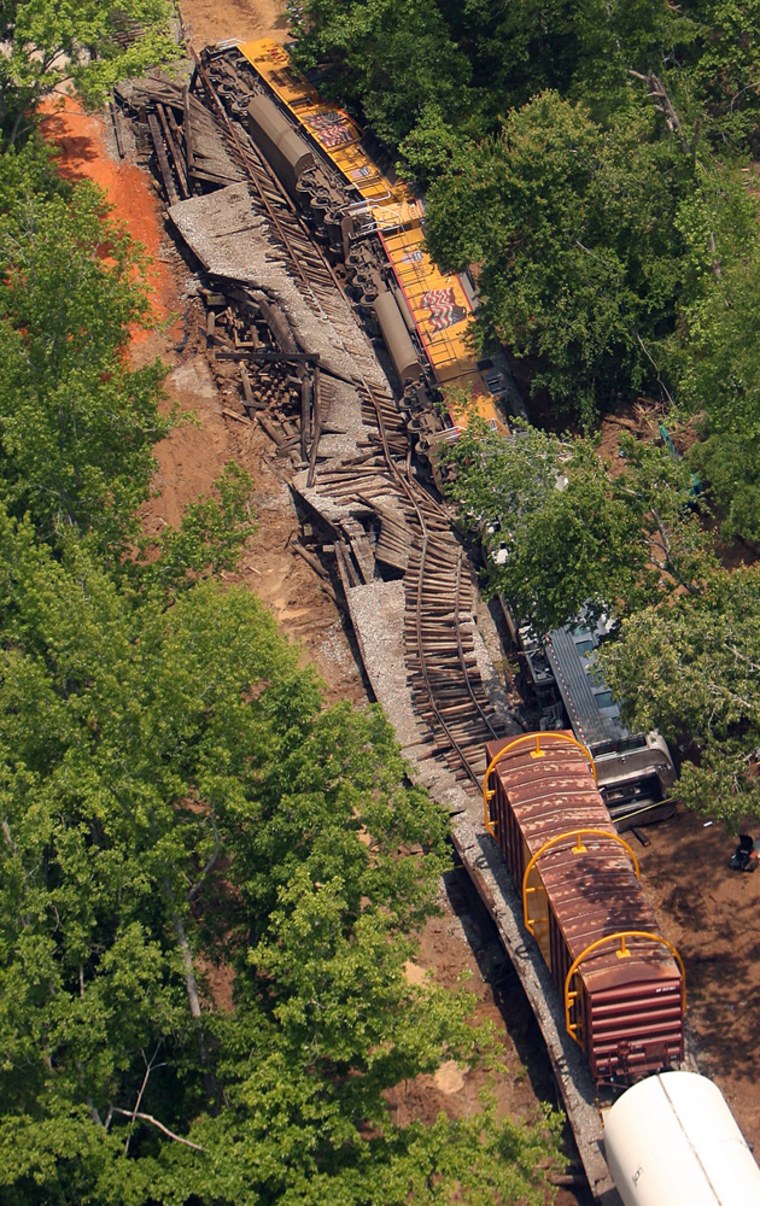A freight train carrying segments of the space shuttle’s solid rocket boosters derailed Wednesday after a bridge sank over boggy ground, authorities said. Six people aboard the train were reported injured.
NASA said it was not immediately known whether the equipment was damaged. But space agency spokesman Allard Beutel in Washington said the accident should not delay any shuttle launches.
The trestle collapse was under investigation.
The shuttle’s twin boosters are 150 feet (45 meters) tall and consist of four propellant segments each. They are used during liftoff and the first two minutes or so of flight to help the spacecraft break free of Earth’s orbit, and are then jettisoned into the sea, after which they are recovered, refurbished and reused.
It was a leak of burning gas between two segments of a solid booster rocket that caused the Challenger explosion that killed seven astronauts in 1986.
“It appears when the train got onto the trestle, the trestle just gave way and sank to the ground,” said Mike Rudolphi, an official with the boosters’ manufacturer who went to the wreck site. “It’s going to be a challenge to get it out of there.”
Eight booster segments were on the train, which carried only the shuttle shipment, Rudolphi said. One booster segment overturned, along with two locomotives and a car carrying six attendants, who were injured.
The segments will probably be sent back to the manufacturer’s Utah plant to be examined, Rudolphi said.
Just sank into the ground
The Alabama Emergency Management Agency said the four derailed train cars landed on their side on the ground in the woods next to the tracks. None of the cargo spilled, and there appeared to be no fire, the agency said.
Twelve rail cars remained upright. It appears those cars didn’t overturn because the trestle — about 300 to 400 feet (90 to 120 meters) long — sank evenly to the ground, Rudolphi said.
Slideshow 12 photos
Month in Space: January 2014
The derailment was in a remote stretch of track near Myrtlewood, about 110 miles (175 kilometers) southwest of Birmingham. Sheriff’s Deputy Kenneth Collier said he was unaware of any threat posed to the public.
“You can’t get any further out in the woods than this,” he said.
NASA spokesman Kyle Herring said the segments were not scheduled for use during the next shuttle flight, the liftoff of Atlantis on June 8, but for missions in October and December. NASA’s solid rocket boosters and their parts are freely interchangeable.
It was the second time in less than a week that the train jumped the tracks while carrying the booster segments across the country from the manufacturer, ATK Launch Systems Group of Promontory, Utah, to Cape Canaveral, Fla., Herring said.
Last Friday, two axles on one car came off the tracks for unknown reasons about 60 miles west of Salina, Kan., while the train was traveling at less than 20 mph, Herring said. The train was back on the tracks after several hours, the spokesman said.
Injuries assessed
A spokesman for the manufacturer, Bryce Hallowell, said the rocket company had two employees and a contractor on the train Wednesday. The other three apparently worked for the rail company, Meridian and Bigbee Railroad. None of the workers' injuries was life-threatening, said Michael Williams, a spokesman for Genesee & Wyoming, the Connecticut-based firm that owns Meridian and Bigbee.
"That's the best news all day," Williams told MSNBC.com.
The train was with Union Pacific when it left Utah but was transferred to Meridian and Bigbee before the derailment. Williams said company representatives as well as local and federal officials were looking into the causes of the trestle collapse.
ATK's Hallowell said he was told that the rocket motors were stable at the accident site. After an inspection, he said, the company will work with the railroad to remove them safely.
NASA officials said two locomotives, a train car behind them, and one car with a shuttle booster overturned. The fuel in the rocket, aluminum perchlorate, has the consistency of a rubber eraser, and there was no danger of it igniting, according to NASA.
Hallowell said the train was taking the same route to the Kennedy Space Center that has been used for 30 years or more. The train trip can take more than a week.
Another ATK spokesman, George Torres, said that the company had additional rocket booster segments in reserve, and those could be sent to Florida as replacements if necessary.
"The bottom line is, no impact to mission," Torres told MSNBC.com.
Run of bad luck
The accident was the latest in a run of bad luck for the space agency.
In February, astronaut Lisa Nowak was arrested on charges of trying to kidnap a romantic rival. Later that month, a freak hail storm caused thousands of dents in space shuttle Atlantis’ external tank as it sat on the launch pad, delaying the flight for months.
Last month, a worker at NASA’s Johnson Space Center in Houston shot a colleague to death and then killed himself.
This report includes information from The Associated Press and MSNBC.com. An earlier version of this story had incorrect information about the operator of the train.

